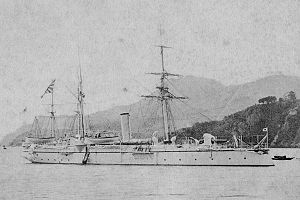Japanese gunboat Chōkai
 Japanese gunboat Chōkai at Sasebo, 1889
| |
| History | |
|---|---|
| Name | Chōkai |
| Ordered | 1883 |
| Builder | Ishikawajima-Hirano Shipyards |
| Laid down | 25 January 1886 |
| Launched | 20 August 1887 |
| Commissioned | 27 December 1888 |
| Decommissioned | 1 April 1908 |
| Stricken | 23 May 1911 |
| Fate | Scrapped 1912 |
| General characteristics | |
| Class and type | Maya-class gunboat |
| Displacement | 614 long tons (624 t) |
| Length | 47.0 m (154.2 ft) |
| Beam | 8.2 m (26 ft 11 in) |
| Draught | 2.95 m (9 ft 8 in) |
| Propulsion |
|
| Speed | 11.0 knots (12.7 mph; 20.4 km/h) |
| Range | 60 tons coal |
| Complement | 104 |
| Armament |
|
| Service record | |
| Operations: | |
Chōkai (鳥海) was an iron-hulled, steam gunboat, serving in the early Imperial Japanese Navy.[1] She was the second vessel to be completed in the four vessel Maya class, and was named after Mount Chōkai in between Yamagata and Akita Prefectures.
Background
Chōkai was an iron-hulled, two-masted gunboat with a horizontal double expansion reciprocating steam engine with two cylindrical boilers driving two screws.[2] She also had two masts for a schooner sail rig.
Chōkai was
Operational history
Chōkai was captained by Lieutenant Commander
On 21 March 1898, Chōkai was re-designated as a second-class gunboat, and was used for coastal survey and patrol duties.[3] During the Boxer Rebellion, she was assigned to patrol off the Taku Forts.
During the
Chōkai was removed from active combat status on 1 April 1908, and was used as a training vessel at the
Notes
- ISBN 0-87021-893-X. page 115
- ^ Chesneau, All the World’s Fighting Ships, p. 236.
- ^ a b c Nishida, Ships of the Imperial Japanese Navy
References
- Corbett, Sir Julian. Maritime Operations in The Russo-Japanese War 1904-1905. (1994) Originally classified, and in two volumes, ISBN 1-55750-129-7
- Chesneau, Roger and Eugene M. Kolesnik (editors), All The World's Fighting Ships 1860-1905, Conway Maritime Press, 1979 reprinted 2002, ISBN 0-85177-133-5
- Jentsura, Hansgeorg (1976). Warships of the Imperial Japanese Navy, 1869-1945. Naval Institute Press. ISBN 0-87021-893-X.
